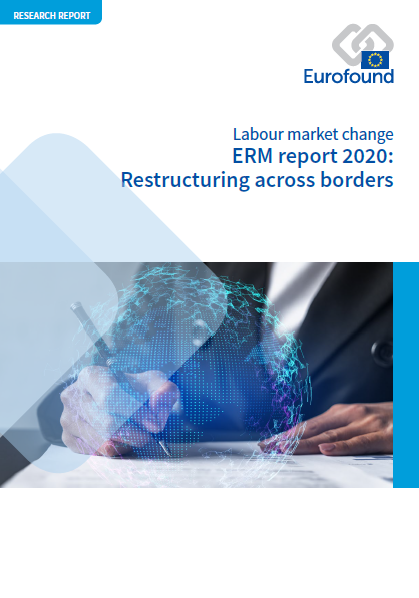
Aruanne keskendub kahele teemale. Esiteks käsitleb see hiljutist restruktureerimist ELis alates 2019. aasta jaanuarist kuni COVID-19 kriisini ja selle esimeste mõjudeni. Teiseks analüüsitakse piiriülese restruktureerimise juhtumeid ehk restruktureerimist, mis mõjutab töötajaid mitmes riigis. Mõlemad analüüsid tuginevad Euroopa restruktureerimise jälgimise keskuse andmebaasile, kuhu on alates asutamisest 2002. aastal kogutud üle 25 000 suuremahulise restruktureerimise andmed, sealhulgas ligi 2000 restruktureerimise kohta alates 2019. aasta algusest.
Piiriülese restruktureerimise andmete ülevaates kasutatakse ka juhtumiuuringuid tootmise rahvusvahelise ümberpaigutamise kohta. Eesmärk on tõsta esile tekkivate vaidluste liigid, samuti see, kuidas juhtkond ja sotsiaalpartnerid juhivad restruktureerimist ning mis on tagajärjed mõjutatud töötajatele.
Key findings
Ligikaudu iga kahekümnes suuremahulise restruktureerimise juhtum on piiriülene, mõjutades tegevust vähemalt kahes riigis. Selliste juhtumite mõju tööhõivele on üldiselt palju suurem ning restruktureerimisprotsess seepärast tavaliselt pikem ja keerukam. ELis väheneb ulatuslikes piiriülese restruktureerimise juhtumites töökohtade arv keskmiselt 3000 võrra.
Restruktureerimine on alati tsükliline ning selle tipptasemed ühtivad majanduslangusega, eriti piiriülesel restruktureerimisel. Nii juhtumite sagedus kui ka juhtude maht (kaotatud töökohtade arv) kasvavad suhteliselt kiiresti majanduslanguse, sealhulgas COVID-19 kriisist tuleneva majanduslanguse ajal.
COVID-19 kriisi tõttu kahekordistus 2020. aasta esimesel poolaastal restruktureerimisest tingitud töökohtade kaotus võrreldes jooksva keskmisega. Mõju tööturule on olnud väga pisteline ning kahes suures sektoris – transport (sh lennutransport) ning hotellid ja restoranid – on kaotatud töökohtade arv ligi pool teatatud kaotatud töökohtade koguarvust (tavaliselt on see alla 10%).
Euroopa töönõukogude suutlikkus mõjutada restruktureerimist on piiratud, mis on ilmsem siis, kui hargmaine otsustamine keskendub ülemaailmsele tasandile – nagu see toimub üha sagedamini – ja mitte kohalikule, riigi ega ELi tasandile.
List of tables
Table 1: Announced job loss and job creation, by broad sector, EU27, Norway and the UK, 2019–Q2 2020
Table 2: Top five offshoring cases, EU27, 2019–Q2 2020
Table 3: Cases of announced job loss and job creation in the car components subsector in Member States and the UK, 2019–Q2 2020
Table 4: Top five cases of announced job loss, EU27, 2019–Q2 2020
Table 5: Top five cases of announced job creation, EU27, 2019–Q2 2020
Table 6: Amazon full-time employee headcount, selected Member States and the UK, 2020
Table 7: Largest COVID-19-related announced job loss restructuring cases, EU27 (national) and worldwide (transnational), March–June 2020
Table 8: Sector and location details of nine transnational offshorings studied
Table A1: MNEs with most restructuring cases, 2005–Q2 2020
Table A2: MNEs with most restructuring cases (2005–Q2 2020) – geographical distribution of employment, 2005–2019
List of graphs
Figure 1: Change in full-time and part-time employment (in thousands), quarterly year on year, 2009–2019, EU27
Figure 2: Announced job loss and job creation, by broad sector, EU27, Norway and the UK, 2019–Q2 2020
Figure 3: Announced job loss cases (%), by restructuring type, EU27, Norway and the UK, 2019–Q2 2020
Figure 4: Origin and destination countries for offshoring, selected Member States and the UK, 2019–Q2 2020
Figure 5: Breakdown of restructuring type by company size, EU27, Norway and the UK, 2008–Q2 2020
Figure 6: Case count and announced job loss and job creation in national restructurings, EU27, Norway and the UK, Q1 2019–Q2 2020
Figure 7: Case count and announced job loss in transnational restructurings, EU27, Norway and the UK, Q1 2019–Q2 2020
Figure 8: Announced job loss distinguished according to whether COVID-19 was indicated as a reason for restructuring, EU27, Norway and the UK, Q2 2020
Figure 9: Announced job loss (%) distinguished according to whether COVID-19 was indicated as a reason for restructuring, by sector, EU27, Norway and the UK, 2019–Q2 2020
Figure 10: Transnational share of ERM cases (%), 2005–Q2 2020
Figure 11: Transnational restructurings – total announced job loss and as share of job loss in national cases, 2005–2020
Figure 12: Restructuring cases (%), by job-loss size category and time frame, 2005–Q2 2020
Figure 13: Transnational and national restructuring cases (%), by restructuring type, 2005– Q2 2020
Figure 14: Restructuring job loss in national and transnational restructurings (%), by broad sector, 2005–Q2 2020
- Number of pages
-
48
- Reference nº
-
EF20024
- ISBN
-
978-92-897-2110-3
- Catalogue nº
-
TJ-AL-20-001-EN-N
- DOI
-
10.2806/581084
- Permalink
Cite this publication
Eurofound (2020), ERM report 2020: Restructuring across borders, European Restructuring Monitor series, Publications Office of the European Union, Luxembourg.
